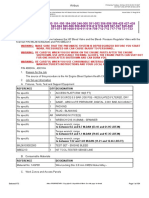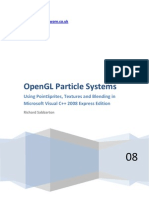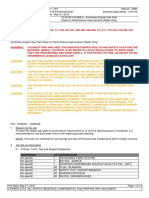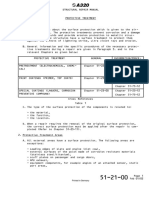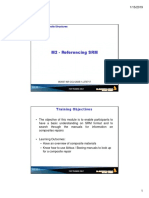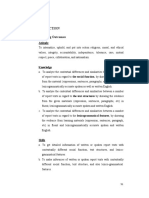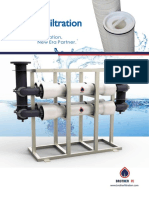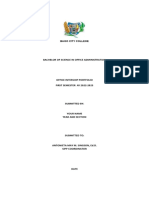AMM Task 28-11-00-790-802-A
AMM Task 28-11-00-790-802-A
Uploaded by
Nguyen Truong SonCopyright:
Available Formats
AMM Task 28-11-00-790-802-A
AMM Task 28-11-00-790-802-A
Uploaded by
Nguyen Truong SonCopyright
Available Formats
Share this document
Did you find this document useful?
Is this content inappropriate?
Copyright:
Available Formats
AMM Task 28-11-00-790-802-A
AMM Task 28-11-00-790-802-A
Uploaded by
Nguyen Truong SonCopyright:
Available Formats
Customer : HVN Manual : AMM
Type : A318/A319/A320/A321 Selected applicability : ALL
Rev. Date : Nov 01, 2017
28-11-00-790-802-A - Leak Test of the Wing Tanks and the Center
Tank - Without Fuel - Pressurized Air and Helium/Air Procedure
** ON A/C ALL
TASK 28-11-00-790-802-A
Leak Test of the Wing Tanks and the Center Tank - Without Fuel - Pressurized Air and Helium/Air Procedure
WARNING: PUT THE SAFETY DEVICES AND THE WARNING NOTICES IN POSITION BEFORE YOU
START A TASK ON OR NEAR:
- THE FLIGHT CONTROLS
- THE FLIGHT CONTROL SURFACES
- THE LANDING GEAR AND THE RELATED DOORS
- COMPONENTS THAT MOVE.
MOVEMENT OF COMPONENTS CAN KILL OR CAUSE INJURY TO PERSONS AND/OR CAN
CAUSE DAMAGE TO THE EQUIPMENT.
WARNING: MAKE SURE THAT YOU HAVE THE CORRECT FIRE FIGHTING EQUIPMENT AVAILABLE.
1. Reason for the Job
Self explanatory
2 Job Set-up Information
A. Fixtures, Tools, Test and Support Equipment
REFERENCE QTY DESIGNATION
No specific AR ACCESS PLATFORM 6M (20 FT)
No specific AR SAFETY BARRIER(S)
No specific AR WARNING NOTICE(S)
(98D27803000000) 1 LOCKING TOOL-FLAP SLAT LEVER,INT. POSITION
(DETTPS8001) 1
(DETTPSH0AI00) 1 AIRBUS HOLDER FOR VENT PLUGS
(DETTPSTAAI001) 1 DRAIN-WATER, INTERFACES
** ON A/C 001-010
(DETTPSVPAI04) 1 VENT PLUG KIT
** ON A/C 011-300
(DETTPSVPAI07) 1 PLUGS-NACA VENT
** ON A/C ALL
(DETW40052) 1
B. Work Zones and Access Panels
ZONE/ACCESS ZONE DESCRIPTION
140 CENTER WING
540 FUEL TANK
550 VENT SURGE TANK
640 FUEL TANK
650 VENT SURGE TANK
C. Referenced Information
Print Date: January 09, 2018 Page 1 of 13
© AIRBUS S.A.S. ALL RIGHTS RESERVED. CONFIDENTIAL AND PROPRIETARY DOCUMENT.
Customer : HVN Manual : AMM
Type : A318/A319/A320/A321 Selected applicability : ALL
Rev. Date : Nov 01, 2017
28-11-00-790-802-A - Leak Test of the Wing Tanks and the Center
Tank - Without Fuel - Pressurized Air and Helium/Air Procedure
REFERENCE DESIGNATION
(Ref. 12-11-28-650-003-A). Pressure Refuel with Automatic Control
(Ref. 12-34-24-869-001-B). Aircraft Bonding and Grounding (Earthing) for the Refuel/Defuel or
Oxygen Servicing Operations
(Ref. 24-41-00-861-002-A). Energize the Aircraft Electrical Circuits from the External Power
(Ref. 24-41-00-861-002-A-01). Energize the Aircraft Electrical Circuits from the APU
(Ref. 24-41-00-861-002-A-02). Energize the Aircraft Electrical Circuits from Engine 1(2)
(Ref. 24-41-00-862-002-A). De-energize the Aircraft Electrical Circuits Supplied from the External
Power
(Ref. 24-41-00-862-002-A-01). De-energize the Aircraft Electrical Circuits Supplied from the APU
(Ref. 24-41-00-862-002-A-02). De-energize the Aircraft Electrical Circuits Supplied from the Engine
1(2)
(Ref. 27-50-00-866-008-A). Extension of the Flaps on the Ground
(Ref. 27-50-00-866-008-A-01). Extension of the Flaps/Slats on the Ground
(Ref. 27-50-00-866-009-A). Retraction of the Flaps on the Ground
(Ref. 27-50-00-866-009-A-01). Retraction of the Flaps/Slats on the Ground
(Ref. 27-80-00-866-004-A). Extending the Slats on the Ground
(Ref. 27-80-00-866-005-A). Retracting the Slats on the Ground
(Ref. 28-10-00-910-001-A). Safety Procedures When You Do Work in a Fuel Tank
(Ref. 28-10-00-910-002-A). Access to the Fuel Tanks and the Work Areas
(Ref. 28-11-00-790-009-A). Leak Test of the Fuel Tanks - Without Fuel - Helium Procedure
(Ref. 28-12-41-200-003-A). Inspection of the Overpressure Protector
(Ref. 28-25-00-650-001-A). Pressure Defuel
(Ref. 28-25-00-650-003-A). To Drain Remaining Fuel from the Wing Tanks and the Center Tank
(Ref. 28-25-00-650-003-A-01). To Drain Remaining Fuel from the Wing Tanks and the Center Tank
(Ref. 31-60-00-860-001-A). EIS Start Procedure
(Ref. 31-60-00-860-002-A). EIS Stop Procedure
(Ref. 51-76-12-300-001-A). Local Repair of the Fuel Tank Sealant
(Ref. 57-27-11-400-001-A). Installation of the Access Panel
(Ref. 57-27-11-400-002-A). Installation of the Access Panel
Helium Mapping Kit - Left Wing Tank and Center Tank - Connections SHEET 1
Helium Mapping Kit - Right Wing Tank - Connections SHEET 1
Print Date: January 09, 2018 Page 2 of 13
© AIRBUS S.A.S. ALL RIGHTS RESERVED. CONFIDENTIAL AND PROPRIETARY DOCUMENT.
Customer : HVN Manual : AMM
Type : A318/A319/A320/A321 Selected applicability : ALL
Rev. Date : Nov 01, 2017
28-11-00-790-802-A - Leak Test of the Wing Tanks and the Center
Tank - Without Fuel - Pressurized Air and Helium/Air Procedure
TPS
AIR/HELIUM
SUPPLY
Fans Pressurization System
TANK PRESSURE
MEASUREMENT
NOTE:
1. WATER DRAIN-VALVE ADAPTER
2. NACA PLUG
3. NACA PLUG HOLDER
4. CONTROL UNIT
N_MM_281100_5_NAM0_01_00
Figure 28-11-00-991-04100-00-A / SHEET 1/1 - Helium
Mapping Kit - Left Wing Tank and Center Tank - Connections
** ON A/C ALL
Print Date: January 09, 2018 Page 3 of 13
© AIRBUS S.A.S. ALL RIGHTS RESERVED. CONFIDENTIAL AND PROPRIETARY DOCUMENT.
Customer : HVN Manual : AMM
Type : A318/A319/A320/A321 Selected applicability : ALL
Rev. Date : Nov 01, 2017
28-11-00-790-802-A - Leak Test of the Wing Tanks and the Center
Tank - Without Fuel - Pressurized Air and Helium/Air Procedure
TPS
AIR/HELIUM
SUPPLY
Fans Pressurization System
2
TANK PRESSURE
MEASUREMENT
NOTE:
1. WATER DRAIN-VALVE ADAPTER
2. CONTROL UNIT
3. NACA PLUG HOLDER
4. NACA PLUG
N_MM_281100_5_NBM0_01_00
Figure 28-11-00-991-04200-00-A / SHEET 1/1 - Helium Mapping Kit - Right Wing Tank - Connections
** ON A/C ALL
Print Date: January 09, 2018 Page 4 of 13
© AIRBUS S.A.S. ALL RIGHTS RESERVED. CONFIDENTIAL AND PROPRIETARY DOCUMENT.
Customer : HVN Manual : AMM
Type : A318/A319/A320/A321 Selected applicability : ALL
Rev. Date : Nov 01, 2017
28-11-00-790-802-A - Leak Test of the Wing Tanks and the Center
Tank - Without Fuel - Pressurized Air and Helium/Air Procedure
3. Job Set-up
Subtask 28-11-00-941-119-A
A. Safety Precautions
WARNING: OBEY THE SAFETY PROCEDURES WHEN YOU DO WORK IN A FUEL TANK.
(1) You must obey the fuel safety procedures when you do work in a fuel tank (Ref. AMM TASK 28-10-
00-910-001) .
(2) Put a WARNING NOTICE(S) in the cockpit to tell persons not to operate the flight controls.
(3) Put the LOCKING TOOL-FLAP SLAT LEVER,INT. POSITION (98D27803000000) on the slat/flap
control lever.
(4) Put the SAFETY BARRIER(S) in position.
Subtask 28-11-00-860-129-A
B. Aircraft Maintenance Configuration
(1) Make sure that the aircraft is grounded (earthed) correctly (Ref. AMM TASK 12-34-24-869-001) .
(2) Energize the aircraft electrical circuits
(Ref. AMM TASK 24-41-00-861-002) .
(3) In the cockpit:
(a) On the panel 25VU, make sure that the APU MASTER SW P/BSW is in the off position (the ON
legend is off).
(b) On the panel 115VU, make sure that the ENG/MASTER 1 and ENG/MASTER 2 switches are in
the OFF position.
(c) On the panel 40VU, make sure that the X FEED P/BSW is released (the ON legend is off).
(4) Do the EIS start procedure (ECAM only) (Ref. AMM TASK 31-60-00-860-001) , then:
· On the ECAM control panel (CP), push (in) the FUEL P/BSW
· Make sure that the FUEL page shows on the ECAM lower display unit (DU).
(5) On the ECAM lower DU, make sure that:
· The engine LP valves are shown closed (amber cross-line)
· The APU LP valve shows closed (green crossed line)
· The X FEED valve shows closed (green crossed line).
(6) On the refuel/defuel panel 800VU, make sure that:
· The MODE SELECT switch is in the OFF and guarded position
· All the REFUEL VALVE switches are in the SHUT position.
(7) Defuel the applicable fuel tank(s) (Ref. AMM TASK 28-25-00-650-001) .
(8) Drain the remaining fuel from the applicable fuel tank(s) (Ref. AMM TASK 28-25-00-650-003) .
(9) Fully extend the flaps and the slats (Ref. AMM TASK 27-50-00-866-008) and (Ref. AMM TASK 27-
80-00-866-004) .
(10) Make sure that the LOCKING TOOL-FLAP SLAT LEVER,INT. POSITION (98D27803000000) is
installed on the slat/flap control lever.
(11) Make sure that the applicable overpressure protector on each NACA inlet is serviceable
(Ref. AMM TASK 28-12-41-200-003) .
(12) Make sure that the manhole access panels of all wing tanks are installed correctly
(Ref. AMM TASK 57-27-11-400-001) and (Ref. AMM TASK 57-27-11-400-002) .
(13) Do the EIS stop procedure (Ref. AMM TASK 31-60-00-860-002) .
Print Date: January 09, 2018 Page 5 of 13
© AIRBUS S.A.S. ALL RIGHTS RESERVED. CONFIDENTIAL AND PROPRIETARY DOCUMENT.
Customer : HVN Manual : AMM
Type : A318/A319/A320/A321 Selected applicability : ALL
Rev. Date : Nov 01, 2017
28-11-00-790-802-A - Leak Test of the Wing Tanks and the Center
Tank - Without Fuel - Pressurized Air and Helium/Air Procedure
(14) De-energize the aircraft electrical circuits
(Ref. AMM TASK 24-41-00-862-002) .
Subtask 28-11-00-010-092-A
C. Get Access
(1) Put the ACCESS PLATFORM 6M (20 FT) in position below the applicable access panel.
(2) Remove the applicable access panels.
(a) To get access to the front of the fuel tank, remove the applicable wing leading-edge access-
panels.
(b) To get access to the rear of the fuel tank, remove the applicable wing trailing-edge access-
panels.
(c) To get access to the center tank, remove the applicable belly fairing access-panel.
4. Procedure
** ON A/C 001-010
Subtask 28-11-00-790-098-A
CAUTION: MAKE SURE THAT THE MAXIMUM PRESSURE IN THE TANK IS NOT MORE THAN 0.1378
BAR (2.0 PSI). THIS WILL PREVENT DAMAGE TO THE FUEL SYSTEM.
A. Leak Test of the Left Wing Tank and the Center Tank - Without Fuel - Pressurized Air and Helium/Air
Procedure
(Ref. Fig. Helium Mapping Kit - Left Wing Tank and Center Tank - Connections SHEET 1)
NOTE: To do the test, use the applicable items from:
- The (DETTPS8001)
- The (DETW40052)
- The VENT PLUG KIT (DETTPSVPAI04)
- The AIRBUS HOLDER FOR VENT PLUGS (DETTPSH0AI00) and
- The DRAIN-WATER, INTERFACES (DETTPSTAAI001) .
(1) Connect the compressed air supply to the control unit (4).
(2) Connect the power supply and set the control unit (4) switch to the ON position.
(3) Install the NACA plug holder (3) on the NACA plug (2).
(4) Install the NACA plug (2) on the left-wing NACA inlet.
(5) Make sure that the NACA plug (2) is connected to the control unit (4).
(6) Connect the water drain-valve adapter (1) from the control unit (4) to the water drain valve 25QM.
(7) Do an air leak test as follows:
(a) Operate the control unit (4) to start the air test.
NOTE: The system will automatically increase the pressure to 0.10 bar (1.5 psi).
(b) When the pressure has got to 0.10 bar (1.5 psi), monitor the pressure in the tank(s) for a period
of 10 minutes.
(c) If the pressure in the tank(s) decreases to less than 0.09 bar (1.3 psi), find the exit point of the
leak.
Print Date: January 09, 2018 Page 6 of 13
© AIRBUS S.A.S. ALL RIGHTS RESERVED. CONFIDENTIAL AND PROPRIETARY DOCUMENT.
Customer : HVN Manual : AMM
Type : A318/A319/A320/A321 Selected applicability : ALL
Rev. Date : Nov 01, 2017
28-11-00-790-802-A - Leak Test of the Wing Tanks and the Center
Tank - Without Fuel - Pressurized Air and Helium/Air Procedure
NOTE: The control unit (4) will keep the air pressure supplied to help to find the exit point of the
leak.
(d) Listen around the tank(s) boundaries for any hissing sounds of air pressure leak.
(e) If a hissing sound is heard, repair the leak.
(f) If the pressure in the tank(s) is stable at 0.09 bar (1.3 psi), operate the control unit (4) to
depressurize the tank(s).
(g) Make sure that the pressure in the tank(s) is back to atmospheric pressure.
(8) Do the air/helium leak test as follows:
(a) Connect the helium supply to the control unit (4).
(b) Set the control unit (4) to supply the air and the helium to the tank(s).
(c) Operate the control unit (4) to start the test.
NOTE: The system will automatically increase the pressure to 0.10 bar (1.5 psi).
(d) Wait for 10 minutes to let the helium mix with the air in the tank(s). This makes sure that there is
approximately 10 percent helium and 90 percent air.
(e) Use the portable helium detector to find the leak point on external surfaces of the tank(s).
NOTE: A fuel leak can move for a long distance in the aircraft structure. Compressed air can be
used to remove the helium build up in the area. This will make it easier to find the point of
the leak.
(f) Make a mark at each exit point as you find them.
NOTE: This will help you to find them when you do a leak test to find the source of the leak.
NOTE: The exit point of leakage can be at a long distance from the source of the leak.
NOTE: Air/helium can leak through the system valves and effect the test results.
(g) Operate the control unit (4) to depressurize the tank(s).
(h) Make sure that the pressure in the tank(s) is fully released before you continue.
(i) Get access to the applicable fuel tank(s) (Ref. AMM TASK 28-10-00-910-002) .
1 Make sure that the remaining helium content in the tank(s) is fully removed, to prevent the
background signal.
(j) Do a leak test at each of the exit points where you made a mark (Ref. AMM TASK 28-11-00-
790-009) .
(k) At source of each leak:
1 Do the necessary repair procedure (Ref. AMM TASK 51-76-12-300-001) .
2 Do the step (8) again to make sure that the leak is repaired.
(9) Remove the NACA plug (2) from the left-wing NACA inlet.
(10) Remove the NACA plug holder (3) from the NACA plug (2).
(11) Remove the water drain-valve adapter (1) from the water drain valve 25QM.
(12) Disconnect the compressed air supply and the helium supply from the control unit (4).
Print Date: January 09, 2018 Page 7 of 13
© AIRBUS S.A.S. ALL RIGHTS RESERVED. CONFIDENTIAL AND PROPRIETARY DOCUMENT.
Customer : HVN Manual : AMM
Type : A318/A319/A320/A321 Selected applicability : ALL
Rev. Date : Nov 01, 2017
28-11-00-790-802-A - Leak Test of the Wing Tanks and the Center
Tank - Without Fuel - Pressurized Air and Helium/Air Procedure
Subtask 28-11-00-790-099-A
CAUTION: MAKE SURE THAT THE MAXIMUM PRESSURE IN THE TANK IS NOT MORE THAN 0.1378
BAR (2.0 PSI). THIS WILL PREVENT DAMAGE TO THE FUEL SYSTEM.
B. Leak Test of the Right Wing Tank - Without Fuel - Pressurized Air and Helium/Air Procedure
(Ref. Fig. Helium Mapping Kit - Right Wing Tank - Connections SHEET 1)
NOTE: To do the test, use the applicable items from:
- The (DETTPS8001)
- The (DETW40052)
- The VENT PLUG KIT (DETTPSVPAI04)
- The AIRBUS HOLDER FOR VENT PLUGS (DETTPSH0AI00) and
- The DRAIN-WATER, INTERFACES (DETTPSTAAI001) .
(1) Connect the compressed air supply to the control unit (2).
(2) Connect the power supply and set the control unit (2) switch to the ON position.
(3) Install the NACA plug holder (3) on the NACA plug (4).
(4) Install the NACA plug (4) on the right-wing NACA inlet.
(5) Make sure that the NACA plug (4) is connected to the control unit (2).
(6) Connect the water drain-valve adapter (1) from the control unit (2) to the water drain valve 26QM.
(7) Do an air leak test as follows:
(a) Operate the control unit (2) to start the air test.
NOTE: The system will automatically increase the pressure to 0.10 bar (1.5 psi).
(b) When the pressure has got to 0.10 bar (1.5 psi), monitor the pressure in the tank for a period of
10 minutes.
(c) If the pressure in the tank decreases to less than 0.09 bar (1.3 psi), find the exit point of the leak.
NOTE: The control unit (2) will keep the air pressure supplied to help to find the exit point of the
leak.
(d) Listen around the tank boundaries for any hissing sounds of air pressure leak.
(e) If a hissing sound is heard, repair the leak.
(f) If the pressure in the tank is stable at 0.09 bar (1.3 psi), operate the control unit (2) to
depressurize the tank.
(g) Make sure that the pressure in the tank is back to atmospheric pressure.
(8) Do the air/helium leak test as follows:
(a) Connect the helium supply to the control unit (2).
(b) Set the control unit (2) to supply the air and the helium to the tank.
(c) Operate the control unit (2) to start the test.
NOTE: The system will automatically increase the pressure to 0.10 bar (1.5 psi).
(d) Wait for 10 minutes to let the helium mix with the air in the tank. This makes sure that there is
approximately 10 percent helium and 90 percent air.
Print Date: January 09, 2018 Page 8 of 13
© AIRBUS S.A.S. ALL RIGHTS RESERVED. CONFIDENTIAL AND PROPRIETARY DOCUMENT.
Customer : HVN Manual : AMM
Type : A318/A319/A320/A321 Selected applicability : ALL
Rev. Date : Nov 01, 2017
28-11-00-790-802-A - Leak Test of the Wing Tanks and the Center
Tank - Without Fuel - Pressurized Air and Helium/Air Procedure
(e) Use the portable helium detector to find the leak point on external surfaces of the tank.
NOTE: A fuel leak can move for a long distance in the aircraft structure. Compressed air can be
used to remove the helium build up in the area. This will make it easier to find the point of
the leak.
(f) Make a mark at each exit point as you find them.
NOTE: This will help you to find them when you do a leak test to find the source of the leak.
NOTE: The exit point of leakage can be a long distance from the source of the leak.
NOTE: Air/helium can leak through the system valves and effect the test results.
(g) Operate the control unit (2) to depressurize the tank.
(h) Make sure that the pressure in the tank is fully released before you continue.
(i) Get access to the applicable fuel tank(s) (Ref. AMM TASK 28-10-00-910-002) .
1 Make sure that the remaining helium content in the tank is fully removed, to prevent the
background signal.
(j) Do a leak test at each of the exit points where you made a mark (Ref. AMM TASK 28-11-00-
790-009) .
(k) At source of each leak:
1 Do the necessary repair procedure (Ref. AMM TASK 51-76-12-300-001) .
2 Do the step (8) again to make sure that the leak is repaired.
(9) Remove the NACA plug (4) from the right-wing NACA inlet.
(10) Remove the NACA plug holder (3) from the NACA plug (4).
(11) Remove the water drain-valve adapter (1) from the water drain valve 26QM.
(12) Disconnect the compressed air supply and the helium supply from the control unit (2).
** ON A/C 011-300
Subtask 28-11-00-790-098-B
CAUTION: MAKE SURE THAT THE MAXIMUM PRESSURE IN THE TANK IS NOT MORE THAN 0.1378
BAR (2.0 PSI). THIS WILL PREVENT DAMAGE TO THE FUEL SYSTEM.
A. Leak Test of the Left Wing Tank and the Center Tank - Without Fuel - Pressurized Air and Helium/Air
Procedure
(Ref. Fig. Helium Mapping Kit - Left Wing Tank and Center Tank - Connections SHEET 1)
NOTE: To do the test, use the applicable items from:
- The (DETTPS8001)
- The (DETW40052)
- The PLUGS-NACA VENT (DETTPSVPAI07)
- The AIRBUS HOLDER FOR VENT PLUGS (DETTPSH0AI00) and
- The DRAIN-WATER, INTERFACES (DETTPSTAAI001) .
(1) Connect the compressed air supply to the control unit (4).
(2) Connect the power supply and set the control unit (4) switch to the ON position.
Print Date: January 09, 2018 Page 9 of 13
© AIRBUS S.A.S. ALL RIGHTS RESERVED. CONFIDENTIAL AND PROPRIETARY DOCUMENT.
Customer : HVN Manual : AMM
Type : A318/A319/A320/A321 Selected applicability : ALL
Rev. Date : Nov 01, 2017
28-11-00-790-802-A - Leak Test of the Wing Tanks and the Center
Tank - Without Fuel - Pressurized Air and Helium/Air Procedure
(3) Install the NACA plug holder (3) on the NACA plug (2).
(4) Install the NACA plug (2) on the left-wing NACA inlet.
(5) Make sure that the NACA plug (2) is connected to the control unit (4).
(6) Connect the water drain-valve adapter (1) from the control unit (4) to the water drain valve 25QM.
(7) Do an air leak test as follows:
(a) Operate the control unit (4) to start the air test.
NOTE: The system will automatically increase the pressure to 0.10 bar (1.5 psi).
(b) When the pressure has got to 0.10 bar (1.5 psi), monitor the pressure in the tank(s) for a period
of 10 minutes.
(c) If the pressure in the tank(s) decreases to less than 0.09 bar (1.3 psi), find the exit point of the
leak.
NOTE: The control unit (4) will keep the air pressure supplied to help to find the exit point of the
leak.
(d) Listen around the tank(s) boundaries for any hissing sounds of air pressure leak.
(e) If a hissing sound is heard, repair the leak.
(f) If the pressure in the tank(s) is stable at 0.09 bar (1.3 psi), operate the control unit (4) to
depressurize the tank(s).
(g) Make sure that the pressure in the tank(s) is back to atmospheric pressure.
(8) Do the air/helium leak test as follows:
(a) Connect the helium supply to the control unit (4).
(b) Set the control unit (4) to supply the air and the helium to the tank(s).
(c) Operate the control unit (4) to start the test.
NOTE: The system will automatically increase the pressure to 0.10 bar (1.5 psi).
(d) Wait for 10 minutes to let the helium mix with the air in the tank(s). This makes sure that there is
approximately 10 percent helium and 90 percent air.
(e) Use the portable helium detector to find the leak point on external surfaces of the tank(s).
NOTE: A fuel leak can move for a long distance in the aircraft structure. Compressed air can be
used to remove the helium build up in the area. This will make it easier to find the point of
the leak.
(f) Make a mark at each exit point as you find them.
NOTE: This will help you to find them when you do a leak test to find the source of the leak.
NOTE: The exit point of leakage can be at a long distance from the source of the leak.
NOTE: Air/helium can leak through the system valves and effect the test results.
(g) Operate the control unit (4) to depressurize the tank(s).
(h) Make sure that the pressure in the tank(s) is fully released before you continue.
Print Date: January 09, 2018 Page 10 of 13
© AIRBUS S.A.S. ALL RIGHTS RESERVED. CONFIDENTIAL AND PROPRIETARY DOCUMENT.
Customer : HVN Manual : AMM
Type : A318/A319/A320/A321 Selected applicability : ALL
Rev. Date : Nov 01, 2017
28-11-00-790-802-A - Leak Test of the Wing Tanks and the Center
Tank - Without Fuel - Pressurized Air and Helium/Air Procedure
(i) Get access to the applicable fuel tank(s) (Ref. AMM TASK 28-10-00-910-002) .
1 Make sure that the remaining helium content in the tank(s) is fully removed, to prevent the
background signal.
(j) Do a leak test at each of the exit points where you made a mark (Ref. AMM TASK 28-11-00-
790-009) .
(k) At source of each leak:
1 Do the necessary repair procedure (Ref. AMM TASK 51-76-12-300-001) .
2 Do the step (8) again to make sure that the leak is repaired.
(9) Remove the NACA plug (2) from the left-wing NACA inlet.
(10) Remove the NACA plug holder (3) from the NACA plug (2).
(11) Remove the water drain-valve adapter (1) from the water drain valve 25QM.
(12) Disconnect the compressed air supply and the helium supply from the control unit (4).
Subtask 28-11-00-790-099-B
CAUTION: MAKE SURE THAT THE MAXIMUM PRESSURE IN THE TANK IS NOT MORE THAN 0.1378
BAR (2.0 PSI). THIS WILL PREVENT DAMAGE TO THE FUEL SYSTEM.
B. Leak Test of the Right Wing Tank - Without Fuel - Pressurized Air and Helium/Air Procedure
(Ref. Fig. Helium Mapping Kit - Right Wing Tank - Connections SHEET 1)
NOTE: To do the test, use the applicable items from:
- The (DETTPS8001)
- The (DETW40052)
- The PLUGS-NACA VENT (DETTPSVPAI07)
- The AIRBUS HOLDER FOR VENT PLUGS (DETTPSH0AI00) and
- The DRAIN-WATER, INTERFACES (DETTPSTAAI001) .
(1) Connect the compressed air supply to the control unit (2).
(2) Connect the power supply and set the control unit (2) switch to the ON position.
(3) Install the NACA plug holder (3) on the NACA plug (4).
(4) Install the NACA plug (4) on the right-wing NACA inlet.
(5) Make sure that the NACA plug (4) is connected to the control unit (2).
(6) Connect the water drain-valve adapter (1) from the control unit (2) to the water drain valve 26QM.
(7) Do an air leak test as follows:
(a) Operate the control unit (2) to start the air test.
NOTE: The system will automatically increase the pressure to 0.10 bar (1.5 psi).
(b) When the pressure has got to 0.10 bar (1.5 psi), monitor the pressure in the tank for a period of
10 minutes.
(c) If the pressure in the tank decreases to less than 0.09 bar (1.3 psi), find the exit point of the leak.
NOTE: The control unit (2) will keep the air pressure supplied to help to find the exit point of the
leak.
(d) Listen around the tank boundaries for any hissing sounds of air pressure leak.
Print Date: January 09, 2018 Page 11 of 13
© AIRBUS S.A.S. ALL RIGHTS RESERVED. CONFIDENTIAL AND PROPRIETARY DOCUMENT.
Customer : HVN Manual : AMM
Type : A318/A319/A320/A321 Selected applicability : ALL
Rev. Date : Nov 01, 2017
28-11-00-790-802-A - Leak Test of the Wing Tanks and the Center
Tank - Without Fuel - Pressurized Air and Helium/Air Procedure
(e) If a hissing sound is heard, repair the leak.
(f) If the pressure in the tank is stable at 0.09 bar (1.3 psi), operate the control unit (2) to
depressurize the tank.
(g) Make sure that the pressure in the tank is back to atmospheric pressure.
(8) Do the air/helium leak test as follows:
(a) Connect the helium supply to the control unit (2).
(b) Set the control unit (2) to supply the air and the helium to the tank.
(c) Operate the control unit (2) to start the test.
NOTE: The system will automatically increase the pressure to 0.10 bar (1.5 psi).
(d) Wait for 10 minutes to let the helium mix with the air in the tank. This makes sure that there is
approximately 10 percent helium and 90 percent air.
(e) Use the portable helium detector to find the leak point on external surfaces of the tank.
NOTE: A fuel leak can move for a long distance in the aircraft structure. Compressed air can be
used to remove the helium build up in the area. This will make it easier to find the point of
the leak.
(f) Make a mark at each exit point as you find them.
NOTE: This will help you to find them when you do a leak test to find the source of the leak.
NOTE: The exit point of leakage can be a long distance from the source of the leak.
NOTE: Air/helium can leak through the system valves and effect the test results.
(g) Operate the control unit (2) to depressurize the tank.
(h) Make sure that the pressure in the tank is fully released before you continue.
(i) Get access to the applicable fuel tank(s) (Ref. AMM TASK 28-10-00-910-002) .
1 Make sure that the remaining helium content in the tank is fully removed, to prevent the
background signal.
(j) Do a leak test at each of the exit points where you made a mark (Ref. AMM TASK 28-11-00-
790-009) .
(k) At source of each leak:
1 Do the necessary repair procedure (Ref. AMM TASK 51-76-12-300-001) .
2 Do the step (8) again to make sure that the leak is repaired.
(9) Remove the NACA plug (4) from the right-wing NACA inlet.
(10) Remove the NACA plug holder (3) from the NACA plug (4).
(11) Remove the water drain-valve adapter (1) from the water drain valve 26QM.
(12) Disconnect the compressed air supply and the helium supply from the control unit (2).
** ON A/C ALL
5. Close-up
Subtask 28-11-00-410-091-A
Print Date: January 09, 2018 Page 12 of 13
© AIRBUS S.A.S. ALL RIGHTS RESERVED. CONFIDENTIAL AND PROPRIETARY DOCUMENT.
Customer : HVN Manual : AMM
Type : A318/A319/A320/A321 Selected applicability : ALL
Rev. Date : Nov 01, 2017
28-11-00-790-802-A - Leak Test of the Wing Tanks and the Center
Tank - Without Fuel - Pressurized Air and Helium/Air Procedure
A. Close Access
(1) Make sure that the work area is clean and clear of tools and other items.
(2) If applicable, install the wing leading-edge access-panels.
(3) If applicable, install the wing trailing-edge access-panels.
(4) If applicable, install the belly fairing access-panels.
Subtask 28-11-00-860-130-A
B. Aircraft Maintenance Configuration
(1) Refuel the applicable fuel tank(s) (Ref. AMM TASK 12-11-28-650-003) .
(2) If applicable, retract the flaps and the slats fully (Ref. AMM TASK 27-50-00-866-009) and
(Ref. AMM TASK 27-80-00-866-005) .
Subtask 28-11-00-942-122-A
C. Removal of Equipment
(1) Remove the SAFETY BARRIER(S).
(2) Remove the access platform(s).
(3) Remove the warning notice(s).
(4) Remove the ground support and maintenance equipment, the special and standard tools and all other
items.
End of document
Print Date: January 09, 2018 Page 13 of 13
© AIRBUS S.A.S. ALL RIGHTS RESERVED. CONFIDENTIAL AND PROPRIETARY DOCUMENT.
You might also like
- Structural Damage Report Form: SDR NoDocument2 pagesStructural Damage Report Form: SDR NoDewin Silva100% (2)
- MCQ On Numerical MethodsDocument5 pagesMCQ On Numerical MethodsMohd Salman100% (1)
- Chapter Number - 05Document5 pagesChapter Number - 05chinna_jet100% (1)
- Funcional Test PDFDocument154 pagesFuncional Test PDFEdwin PerezNo ratings yet
- Amigurumi Zebra Toy - Free Crochet Pattern: Olena's Crafts Original Pattern by Olena HuffmireDocument8 pagesAmigurumi Zebra Toy - Free Crochet Pattern: Olena's Crafts Original Pattern by Olena HuffmiremurkyNo ratings yet
- OpenGL - Particle System Tutorial - Blending - Point SpritesDocument20 pagesOpenGL - Particle System Tutorial - Blending - Point SpritesPaulo GarciaNo ratings yet
- 4Document17 pages4Jai DeepNo ratings yet
- On A/C All: Reference Qty DesignationDocument21 pagesOn A/C All: Reference Qty DesignationRalph Fernandes100% (1)
- TAP - A330 Engine Dry-MotoringDocument9 pagesTAP - A330 Engine Dry-MotoringEdson CarvalhoNo ratings yet
- Emergency Generator TestDocument4 pagesEmergency Generator TestSarbari SenguptaNo ratings yet
- 32-41!11!400-801-A - Installation of The MLG WheelDocument10 pages32-41!11!400-801-A - Installation of The MLG Wheelrüşdi işlerNo ratings yet
- Fill The Hydraulic Fluid Reservoir With A Hand PumpDocument20 pagesFill The Hydraulic Fluid Reservoir With A Hand PumpnobertadilNo ratings yet
- Cabin Odors or SmokeDocument4 pagesCabin Odors or SmokevictorNo ratings yet
- On A/C MSN All: ATR-A-00-65-XX-10000-021A-DDocument9 pagesOn A/C MSN All: ATR-A-00-65-XX-10000-021A-DDVSNo ratings yet
- 700 29 027 BasicDocument13 pages700 29 027 BasicHimanshu Pant100% (1)
- Apu Load Control Valve R IDocument7 pagesApu Load Control Valve R IBoeing MaxNo ratings yet
- Engineering Department: Piper Aircraft IncDocument9 pagesEngineering Department: Piper Aircraft Inccarlos martinezNo ratings yet
- Change Idg Oil FilterDocument5 pagesChange Idg Oil FilterRindang Sitanggang100% (1)
- 32-41-11-400-006-A - Installation of The MLG WheelDocument28 pages32-41-11-400-006-A - Installation of The MLG WheelYaser SahiboleNo ratings yet
- DFDFGD: THA - A318/A319/A320/ A321 Tail Number - MSN - FSN HS-TXP - 06254 - 015Document20 pagesDFDFGD: THA - A318/A319/A320/ A321 Tail Number - MSN - FSN HS-TXP - 06254 - 015KamalVirkNo ratings yet
- Initial Human Factors in Aircraft MaintenanceDocument10 pagesInitial Human Factors in Aircraft MaintenanceAli NugrohoNo ratings yet
- On A/C All: Reference Qty DesignationDocument7 pagesOn A/C All: Reference Qty DesignationRicardoBillEdwinNo ratings yet
- MLG RemovalDocument14 pagesMLG Removalbilly100% (1)
- GVI Brake Units - 32-40-00-210-801-A PDFDocument4 pagesGVI Brake Units - 32-40-00-210-801-A PDFpannNo ratings yet
- A320fam Iae Ata80 Starting PDFDocument24 pagesA320fam Iae Ata80 Starting PDFshabbirjama103No ratings yet
- Managing Smoke and Fumes in FlightDocument10 pagesManaging Smoke and Fumes in FlightJamesNo ratings yet
- AMM - IGO - A318/A319/A320/A321 REV DATE: Aug 01/2021 Tail Number - MSN - FSN: VT-ILN - 10151 - 431Document5 pagesAMM - IGO - A318/A319/A320/A321 REV DATE: Aug 01/2021 Tail Number - MSN - FSN: VT-ILN - 10151 - 431Rameswar PradhanNo ratings yet
- 51-21-00-001-Protective Treatment-A320Document4 pages51-21-00-001-Protective Treatment-A320FredNo ratings yet
- FAA 2012 0721 0009 - Attachment - 5Document119 pagesFAA 2012 0721 0009 - Attachment - 5CHIMONo ratings yet
- Airbus: AdvanceDocument29 pagesAirbus: AdvanceLeonid Gurulev100% (1)
- APU 320 FinishedDocument38 pagesAPU 320 FinishedGalaxy A32No ratings yet
- 90-02-15 FaaDocument2 pages90-02-15 FaaJoan MontesNo ratings yet
- a320-A321-Refuel-Defuel System - Task Supporting DataDocument15 pagesa320-A321-Refuel-Defuel System - Task Supporting Data553486151No ratings yet
- A330 Chapter 47Document71 pagesA330 Chapter 47Chairul IchwanNo ratings yet
- EfcsDocument4 pagesEfcsJai DeepNo ratings yet
- EU4 D1 M2 Referencing SRMDocument18 pagesEU4 D1 M2 Referencing SRMaerorenNo ratings yet
- Daily Check A320 (Issue 02 Rev 04)Document8 pagesDaily Check A320 (Issue 02 Rev 04)Junaid YounusNo ratings yet
- FAST52Document21 pagesFAST52Vahid AlimoradiNo ratings yet
- Dy CHK - 400 2015 New 737 BOOK NG 00 103Document23 pagesDy CHK - 400 2015 New 737 BOOK NG 00 103Syed Salman UddinNo ratings yet
- HAECO Job Applicant Declaration Form - FORM0W00086R01 - 202305 (AGUNG.P)Document2 pagesHAECO Job Applicant Declaration Form - FORM0W00086R01 - 202305 (AGUNG.P)tenhero92No ratings yet
- Single Aisle Technical Training Manual T1 (IAE V2500) (LVL 2&3) PneumaticDocument50 pagesSingle Aisle Technical Training Manual T1 (IAE V2500) (LVL 2&3) PneumaticAnh NguyenXuanNo ratings yet
- TASK 12!13!79-610-011-A Check Oil Level and ReplenishDocument6 pagesTASK 12!13!79-610-011-A Check Oil Level and ReplenishSatishReddyNo ratings yet
- Aircraft General PracticesDocument74 pagesAircraft General Practiceslivonius100% (1)
- B737 B2 TNA Jul RevisedDocument12 pagesB737 B2 TNA Jul ReviseduspaulrusselNo ratings yet
- Ac Fluid AssignmentDocument27 pagesAc Fluid AssignmentLee FzlNo ratings yet
- 7 CAAT-AIR-GM03 Guidance-Material-for-Foreign-Approved-Maintenance-Organization - I3R0 - 30oct2019 PDFDocument59 pages7 CAAT-AIR-GM03 Guidance-Material-for-Foreign-Approved-Maintenance-Organization - I3R0 - 30oct2019 PDFJindarat KasemsooksakulNo ratings yet
- Offwing Alide InstallDocument16 pagesOffwing Alide InstallAndreea MăgureanuNo ratings yet
- A320 STD 1.6.0 Service Bulletin (D00621300)Document11 pagesA320 STD 1.6.0 Service Bulletin (D00621300)Bambi513No ratings yet
- A320 30 L1 TMDocument48 pagesA320 30 L1 TMSaman Mahdi Abadi100% (2)
- A320 Ata 27 Controles de VueloDocument182 pagesA320 Ata 27 Controles de Vuelomiguel alemanNo ratings yet
- Tfu 28.46.00.009Document4 pagesTfu 28.46.00.009Reksa Karisma YogasmaraNo ratings yet
- FE-V2500-1IA - Glossary of TermsDocument19 pagesFE-V2500-1IA - Glossary of TermsnegrotettNo ratings yet
- IAD - A318 - A319 - A320 - A321 - AMM - 01-Aug-2021 - 29-00-00-790-001-A - Check of The External Leaks of The Hydraulic ComponentsDocument12 pagesIAD - A318 - A319 - A320 - A321 - AMM - 01-Aug-2021 - 29-00-00-790-001-A - Check of The External Leaks of The Hydraulic ComponentsMONOJ ANo ratings yet
- 30 45 00001Document6 pages30 45 00001ryan liaoNo ratings yet
- A320PW11G-B12-0007.7, 79 Oil, R1, 010217Document34 pagesA320PW11G-B12-0007.7, 79 Oil, R1, 010217Marwa MandeelNo ratings yet
- FOT Gravity FeedingDocument2 pagesFOT Gravity Feedingpedati0% (1)
- Ata 21 TrsonDocument160 pagesAta 21 TrsonTam Ho100% (1)
- CAA 2101 Aircraft LogbookDocument98 pagesCAA 2101 Aircraft LogbookOsm For ChristNo ratings yet
- Amm LgciuDocument6 pagesAmm LgciuVolNo ratings yet
- Ata25 AirbusDocument308 pagesAta25 AirbusOliver Barrientos100% (1)
- Ata 36 PneumaticDocument30 pagesAta 36 PneumaticSohaib Aslam ChaudharyNo ratings yet
- AMM - AVA - A318/A319/A320/A321 REV DATE: May 01/2024 Tail Number - MSN - FSN: N919AV - 11584 - 874Document12 pagesAMM - AVA - A318/A319/A320/A321 REV DATE: May 01/2024 Tail Number - MSN - FSN: N919AV - 11584 - 874Lucas SuarezNo ratings yet
- Pressure DefuelDocument14 pagesPressure DefuelIvan KryskoNo ratings yet
- B. Main Section m3 La3Document14 pagesB. Main Section m3 La3mapriNo ratings yet
- Brother Filtration, New Era PartnerDocument16 pagesBrother Filtration, New Era PartnerCarlos BarriosNo ratings yet
- Lgricos Gla531 SeriesDocument71 pagesLgricos Gla531 SeriesHouceine BouyaNo ratings yet
- Welding ManualDocument32 pagesWelding ManualHammondMachineNo ratings yet
- Final Ism PresentationDocument31 pagesFinal Ism Presentationapi-250164151No ratings yet
- High AvailabilityDocument38 pagesHigh AvailabilityathulyabeenaraniNo ratings yet
- E-Versuri Ro - Rihana - UmbrelaDocument2 pagesE-Versuri Ro - Rihana - Umbrelaanon-821253100% (1)
- Max Dupain ModernistDocument32 pagesMax Dupain ModernistFrancisco FernandezNo ratings yet
- Scalability and PerformanceDocument2 pagesScalability and Performanceymcbxq8694No ratings yet
- Del Castillo - Case StudyDocument2 pagesDel Castillo - Case StudyD Social MagicNo ratings yet
- Wa0003.Document11 pagesWa0003.Sandeep ChitteNo ratings yet
- Yield Strength MatcalcDocument91 pagesYield Strength MatcalcSibnath Kayal0% (1)
- ErrorChecking1 QuestionsDocument9 pagesErrorChecking1 QuestionsChrisNo ratings yet
- Technical Data Sheet: Speaker Cable Model: CBBR0411Document1 pageTechnical Data Sheet: Speaker Cable Model: CBBR0411Adrian BirdeaNo ratings yet
- Rule 130Document151 pagesRule 130RM MallorcaNo ratings yet
- Guideline G-17 Impacto en MaterialesDocument2 pagesGuideline G-17 Impacto en MaterialesLuis OrtizNo ratings yet
- Chapter 4 Securities Operations and Risk Management PDFDocument84 pagesChapter 4 Securities Operations and Risk Management PDFMRIDUL GOELNo ratings yet
- Yu Huang 2019 DifficultyDocument17 pagesYu Huang 2019 Difficulty8bdsc7cpzvNo ratings yet
- CSEC Mathematics June 2000 P2Document11 pagesCSEC Mathematics June 2000 P2zarzsultan12100% (1)
- BZX85 - C62Document5 pagesBZX85 - C62Luis Enrique PariapazaNo ratings yet
- Research Problem, Conceptual and Theoretical FrameworkDocument22 pagesResearch Problem, Conceptual and Theoretical FrameworkAbdishakur Dahir MuseNo ratings yet
- BSOA OFFICE INTERNSHIP PORTFOLIO Table of Content and Cover PageDocument6 pagesBSOA OFFICE INTERNSHIP PORTFOLIO Table of Content and Cover PageAleza Deniega LebrezaNo ratings yet
- Sof Machine Gun FamilyDocument15 pagesSof Machine Gun FamilyAbhijit DasNo ratings yet
- Text Book References (Stewart)Document3 pagesText Book References (Stewart)ANo ratings yet
- TDS - Vinyl 901-3 (En)Document2 pagesTDS - Vinyl 901-3 (En)OXY Composite TechNo ratings yet
- Design of Load Bearing StructuresDocument12 pagesDesign of Load Bearing StructuresKarthikeya SarmaNo ratings yet
- Instant Download Pharmacology A Patient Centered Nursing Process Approach 9th Edition Mccuistion Solutions Manual PDF Full ChapterDocument32 pagesInstant Download Pharmacology A Patient Centered Nursing Process Approach 9th Edition Mccuistion Solutions Manual PDF Full ChapterTonyaJohnsonDDSrzjt100% (18)



